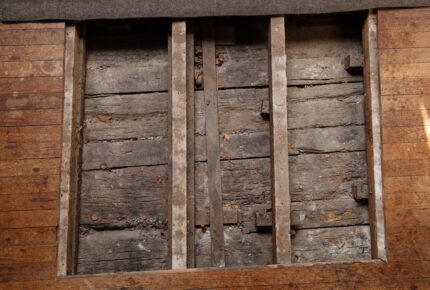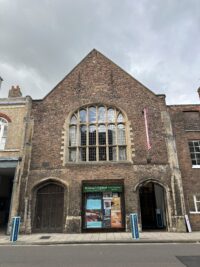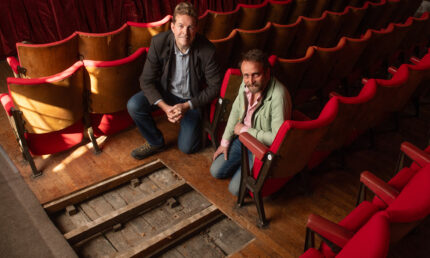 Original 15th century oak floorboards discovered at St George’s Guildhall in King’s Lynn, Norfolk, are the only surviving stage from Shakespeare and are believed to have been trodden by the Bard himself. The floorboards were discovered under two layers of modern flooring, the top one installed in the 1950s and a second from the 18th or 19th century. The planks are massive — six inches thick and a foot wide — and were secured with wooden pegs rather than nails, a signature of medieval construction. Samples of the boards were dendrochronologically dated to between 1417 and 1430.
Original 15th century oak floorboards discovered at St George’s Guildhall in King’s Lynn, Norfolk, are the only surviving stage from Shakespeare and are believed to have been trodden by the Bard himself. The floorboards were discovered under two layers of modern flooring, the top one installed in the 1950s and a second from the 18th or 19th century. The planks are massive — six inches thick and a foot wide — and were secured with wooden pegs rather than nails, a signature of medieval construction. Samples of the boards were dendrochronologically dated to between 1417 and 1430.
St George’s Guildhall is the oldest, largest and most complete medieval guildhall in England. It was built by the medieval Guild of St George, a religious membership organization founded in 1376 for members to receive aid in case of sickness or and burial services, masses and offerings at the altar of St George in the Church of St Margaret, King’s Lynn, after their death. Property records indicate the guild bought the land for the hall in 1406 and it was built between 1410 and 1420. By 1428, it was in active use.
 The first recorded use of the guildhall as a theater was in January 1445 when the guild put on a nativity play before a feast. After that, the organization staged theatrical performances with religious motifs regularly for a century. The Guild of St George fell victim to King Edward VI’s Dissolution of the Guilds in 1547, the son’s continuation of his father Henry VIII’s forcible elimination of church organizations and confiscation of their properties under the aegis of the Protestant Reformation.
The first recorded use of the guildhall as a theater was in January 1445 when the guild put on a nativity play before a feast. After that, the organization staged theatrical performances with religious motifs regularly for a century. The Guild of St George fell victim to King Edward VI’s Dissolution of the Guilds in 1547, the son’s continuation of his father Henry VIII’s forcible elimination of church organizations and confiscation of their properties under the aegis of the Protestant Reformation.
That’s when the guildhall became a full-time working theater. Travelling theatrical companies staged plays in their repertoire there, most notably the Earl of Pembroke’s Men, William Shakespeare’s company, in 1593 when all of London’s theaters were shuttered due to an outbreak of plague. It continued to serve as a playhouse off and on, with gaps during the Commonwealth when Cromwell’s buzzkills outlawed this type of play and stints as a customs house, button factory and county court. Its last period as a dedicated theater was between 1766 and 1814, after which It was sold to the Merchant family and was used as a warehouse. In the early 20th century it was sold to scenic arts who built outdoor theater sets.
 By the end of World War II, the guildhall was in a parlous state with holes in the roof and one wall leaning outwards. It was at risk of being demolished to make way for a parking lot. It was bought by Alexander Penrose who saved it with support from the then Queen Elizabeth (the late Queen Mother) and Princess Diana’s grandmother Lady Fermoy whose husband had once been mayor of King’s Lynn and its representative to Parliament. Queen Elizabeth the Queen Mother officially opened the refurbished St George’s Guildhall as a theater and arts center in 1951.
By the end of World War II, the guildhall was in a parlous state with holes in the roof and one wall leaning outwards. It was at risk of being demolished to make way for a parking lot. It was bought by Alexander Penrose who saved it with support from the then Queen Elizabeth (the late Queen Mother) and Princess Diana’s grandmother Lady Fermoy whose husband had once been mayor of King’s Lynn and its representative to Parliament. Queen Elizabeth the Queen Mother officially opened the refurbished St George’s Guildhall as a theater and arts center in 1951.
Today, St George’s Guildhall belongs to the National Trust and is on long-term lease to King’s Lynn & West Norfolk Borough Council. It has long been underused and poorly frequented, but a new project is now under way to transform the theater and surrounding buildings into a nationally-important culture and arts hub. Renovation work began two months ago, and the original floor emerged last month.
Dr Jonathan Clark, an expert in historical buildings, was brought on board to research the venue. “We wanted to open up an area just to check, just to see if there was an earlier floor surviving here. And lo and behold, we found this,” he says, pointing through a temporary trapdoor. […]
Dr Clark believes this is a hugely important discovery because not only is it the largest 15th Century timber floor in the country, but it would also be the sole surviving example of a stage on which Shakespeare acted.
“It’s the only upper floor, which is in something of its original state, where he could have been walking, could have been performing,” he says.